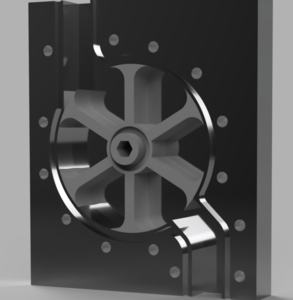
College of Engineering Unit:
The rotary exit valve for a fluidized bed heat exchanger is a motorized, rotational system, designed for multiphase (solid with gas) flow applications. SoFuel Research Group sponsored the valve design project to support in-house thermochemical energy storage research and development. The Research Group is funded by the U.S. Department of Energy and is developing a fluidized bed heat exchanger for concentrated solar power generation systems. Heat exchanger research and design requires an exit valve which keeps fluidizing gas inside the reactor while allowing controlled solid particle flow out to the environment.
Rotary valve operation allows the flow of a solid phase (fluid bed reactor solids) and restricts a gas phase (fluidizing gas). A stepper motor turns a rotor inside the valve housing, moving solids through the system from inlet to outlet. The rotor and housing must be machined with precision to prevent air flow leaks. Geometries for multiphase rotors are designed to prevent solid particle bridging against the rotor housing. As a preliminary design specified for a cold prototype fluid bed reactor, materials selection consists of aluminum housing and motor mounts, with a SLA (stereolithography) 3D-printed rotor.
Testing shows promising gas phase results with a range of 23% to 56% air leak improvement over the previous SoFuel exit valve design (0%). Particle bridging has been virtually eliminated at the recommended rotational speeds of 20-30 RPM. Continuous operation without stalling/bridging allows for SoFuel prototype laboratory experiments with compressed air and 2 mm, 3 mm, and 4 mm simulant spheres. The motorized exit valve allows programmable work cycles, rotation speeds, and rotation directions for practical operation during experiments. Short assembly times of less than eight minutes in case of cleaning or repairs allows for more time experimenting. A standard operating procedure manual details programming, assembly/disassembly, and manufacturing tips for rebuilds.
Industry Sponsor(s):